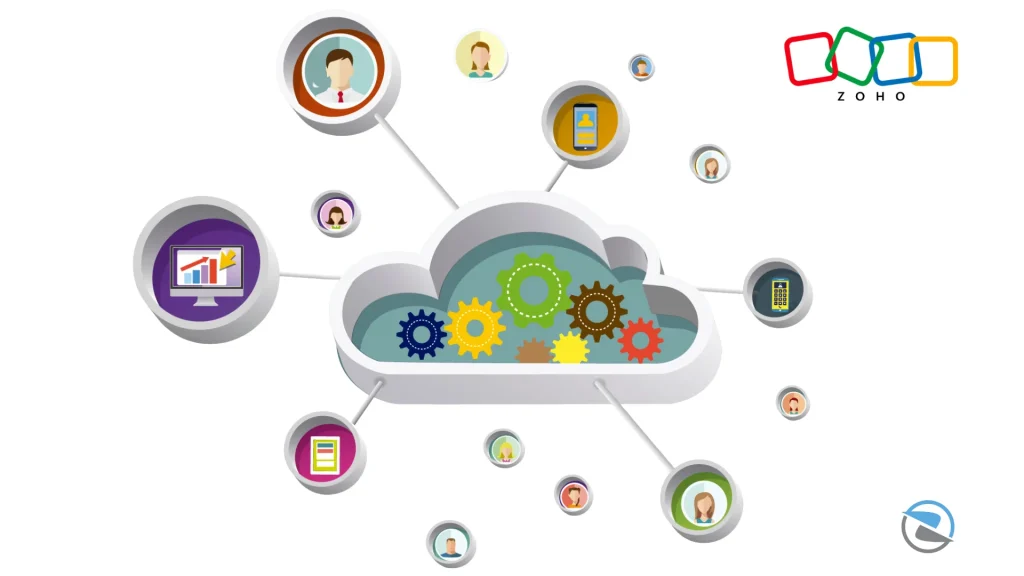In the modern fast-paced digital world, businesses turn to automation to ensure efficiency, reduce repetitive work, and increase productivity—and when it comes to choosing a platform, the decision to be made typically involves Zoho Flow vs. Zapier, two of the most robust workflow automation options. As good as both solutions are at facilitating app connections and process automation, each one was designed with specific use cases in mind.
Zoho Flow is THE pick for businesses who heavily use Zoho(+advanced customizations, multi-step workflows, cost efficiency), while Zapier sits on an unbeatable list of app integrations (5,000+) a user-friendly mechanism that makes it the perfect match for those who value simplicity and wide third-party support above all else.Adding to the saturation of choices, Zoho Flow and Zapier are two of the most widely used workflow automation tools. But which is the most suitable for your business? In this extensive comparison guide, let’s discuss features, integrations, pricing, user experience, and more, and help you in making the right decision.
What Are Zoho Flow and Zapier?
Zoho Flow is an Integration and Automation platform built for Zoho Corporation that enables users to connect cloud applications and automate complex business workflows. It provides a graphical user interface for users to create complex systems, called “flows,” that can link a variety of otherwise separate applications.
Zapier is a popular automation platform that integrates 3,000-plus apps, so you can automate common tasks without any coding. With its easy-to-use interface and its vast app library, it has quickly become the favorite of business owners in the small to medium size range.

“Even if we do not talk about 5G (specifically), the security talent in general in the country is very sparse at the moment. We need to get more (security) professionals in the system”
Core Features Comparison
Ease of Use & User Interface
Zoho Flow: Created with a visual builder so the user can create simple work-flows with the drag and the drop option. It gives a clean UI that should be comfortable to users of Zoho’s ecosystem but can be a bit intimidating for newbies.
Zapier: Understanding and easy to use. Even non-technical users can get on board with automation thanks to the app’s guided steps for creating Zaps. The predefined templates help in getting started quickly.
Supported Integration
Zoho Flow: Zoho Flow is building an ecosystem with over 400 apps, including leading apps like G Suite, Slack, Mailchimp and Zoho’s own suite of apps,” the company stated in a post announcing the new feature. It primarily prioritizes integration with Zoho applications alongside specific third-party services.
Zapier: With support for connecting with over 3,000 applications, including specialized tools and niche software, Zapier stands out for its exceptional versatility. This extensive selection empowers users to link almost any app within their workflow.
Workflow Capabilities
Zoho Flow: Enables intricate workflows incorporating conditional logic, multi-step processes, and live data synchronization. It caters to advanced automation requirements, catering to more complex business demands.
Zapier: Excels in uncomplicated to moderately complex workflows, utilizing multi-step Zaps, filters, and timing delays. Its user-friendly approach makes it perfect for simple automation tasks..
Pricing Models
Zoho Flow: Provides a subscription plan with varying plans, beginning with a free plan with limited workflows. Paid plans give you more tasks and premium features, and get more affordable still if you already use other Zoho products in your business.
Zapier: Offers a free plan with limited Zaps and monthly tasks. Higher tiered paid plans increase task limits and feature multi-step Zaps, premium app connections and priority support.
Customization & Flexibility
Zoho Flow: Is fully customizable with conditional logic, multi-step forms and real-time data updates. It’s appropriate for users looking for customizable automation options.
Zapier: mphasizes simplicity and basic options, but you get plenty of customization features via filters, delays, and multi-step Zaps. Experienced users may employ code steps for additional functionality.
Monitoring & Analytics

Zoho Flow: Offers great dashboards to give you a complete view of your workflows, task executions, error troubleshooting. Its analytics can be leveraged to maximize automation effectiveness.
Zapier: Generates task history logs and notifications to help you track your Zaps. Although powerful, the analytics are more simple than those of Zoho Flow.
Security & Compliance
Zoho Flow: If you use the processes from Zoho Flow, which you probably will, you will also have processes that adhere to various security standards like GDPR and ISO certifications. Data encryption and secure API connections guarantee data security.
Zapier: Also follows security standards in the industry, same encrypted data transfer, and compliance certifications for user’s trust.
Pros and Cons
Zoho flow
Pros:
- Best of all – integrates with the Zoho suite (CRM, Projects, Books, etc.)
- Workflow – Workflow automation expertise with Pardot + Conditional Logic
- Cost-effective for Zoho user
- Robust monitoring and analytics.
Cons:
- Less extensive app ecosystem than on Zapier
- Learning curve may be a bit steep for novices
- Limited community resources.
Zaiper
Pros:
- Massive software integrations (3,000+ apps)
- Intuitive interface designed for non-technical users
- Large library of pre-built templates
- Strong community and support resources
Cons:
- Becomes costly when tasks go up to high volume
- Not as good with heavy workflows as Zoho Flow

Conclusion
Zoho Flow vs. Zapier: Which Automation Tool to Choose Both Zoho Flow and Zapier are solid automation platforms, but they provide different pros and cons: Zoho Flow https://zilltech.net/contact/ is best suited to businesses heavily invested in the Zoho ecosystem, with advanced workflow features, conditional logic, and cost-effective pricing especially for complex automations—whereas Zapier is the most user-friendly and supports integration with more than 5,000 third-party apps, making it ideal for businesses with a wide range of software stacks who value ease of use over advanced customizability. If you’re wanting more extensive connections to Zoho and to take advantage of more advanced automation on a budget, you should go for Zoho Flow, but for low-effort, seamless app connection Zapier is the place to be.
The best pick will be a matter of whether you’re more interested in saving money and getting advanced features inside Zoho (Flow), or keeping things simple and user-friendly (Abspire). Unmatched. Spinner And the right tool for you ultimately depends on your business’s specific needs—Zoho Flow for Zoho shops looking for deep automation without high costs, or Zapier for anyone in search of easy-to-make, far-reaching connections that cut across a sprawling software universe. The verdict? There’s no magic answer to this question, but by grasping these key differences, you’ll determine the right automation powerhouse to elevate your business productivity.




